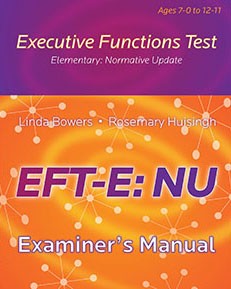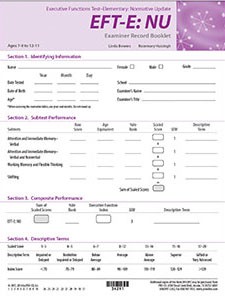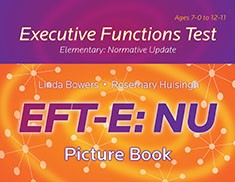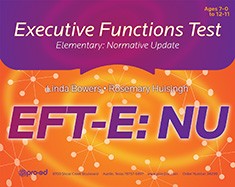Executive Functions Test - Elementary: Normative Update (EFT-E: NU)
- Ages 7 - 12
- Testing Time 60 minutes
- Administration Individual
- Copyright 2017
-
Product Code 34290 ( MR #066509 )
* Qualifications required to purchase this item. Click here to complete the qualifications form.
Price $252.00
Contents
-

Executive Functions Test - Elementary: Normative Update (EFT-E: NU)
EFT-E:NU Examiner's Manual
$87.00 -

Executive Functions Test - Elementary: Normative Update (EFT-E: NU)
EFT-E:NU Examiner Record Booklets (25)
$59.00 -

Executive Functions Test - Elementary: Normative Update (EFT-E: NU)
EFT-E:NU Picture Book
spiral bound
$114.00
- The norms have been updated to reflect the demographics of the 2015 U.S. Census.
- The normative sample (N = 647) is stratified by age relative to geographic region, gender, race, and ethnicity.
- A new standard score metric has been implemented for subtests and composites (M = 10, SD = 3; M = 100, SD = 15).
- New item-analysis and item-bias studies provide convincing evidence of content-description validity.
- New reliability and validity studies were prepared, including diagnostic accuracy analyses, which are considered the most rigorous techniques for establishing a test’s validity. These analyses involve the computation of sensitivity and specificity indexes and the receiver operating characteristic/area under the curve (ROC/AUC) statistic.
-

Executive Functions Test - Elementary: Normative Update (EFT-E: NU)
EFT-E:NU Examiner's Manual
$87.00 -

Executive Functions Test - Elementary: Normative Update (EFT-E: NU)
EFT-E:NU Examiner Record Booklets (25)
$59.00 -

Executive Functions Test - Elementary: Normative Update (EFT-E: NU)
EFT-E:NU Picture Book
spiral bound
$114.00
No additional information available for this item.

 Proud to be Canadian
Proud to be Canadian